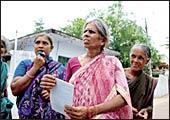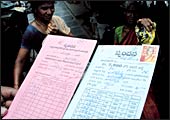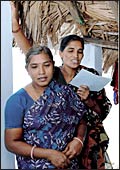 |
|
|
 |
| Credit check: Ammamani (above) and Seshamma
(foreground, top right) are typical micro borrowers, who have
multiple loans, often more than their incomes. A dip in earnings,
then, can send them hurtling into the debt trap |
AUGUST
26, 2006
Mylavaram & Tadigadapa, Krishna District, Andhra Pradesh
From
B. Seshamma's question, it is evident that trust isn't one of
Tadigadapa's most abundant resources-at least of late. "Have
you come for yourself or to do something for us?" she asks.
"Are you from the government or from a newspaper?" questions
her suspicious friend, Sivakumari, spotting the photographer by
my side. If nerves are taut in this sleepy village in the Krishna
district, 270 km from Hyderabad, it's because things look bleaker
now than what they did five months ago. It was in March this year,
that Mylavaram, its neighbouring nondescript village shot into
national fame after the district's young collector, Navin Mittal,
raided offices of microfinance institutions (MFIs) and ordered
30 of them shut, including those of better-known MFIs such as
Share Microfin and Spandana.
What provoked Mittal's action were reports
of alleged abuse in the microfinance business. There were three
major complaints against the MFIs operating here: One, that they
were charging usurious rates of interest, ranging from 40 to 60
per cent per annum; two, they were abusing human rights by detaining
relatives of defaulters or suggesting to borrower's family that
the borrower commit suicide for insurance money; and three, that
they were creating large-scale rural indebtedness.
How do things look five months on? Not too
good. There have been no fresh disbursements from the MFIs over
the last five months and neither have the borrowers been paying
their installments. Borrowers like G. Sarala, Seshamma and Mancham
Ammamani are willing to repay-provided they get fresh loans. Therein
lies the key to the microfinance muddle. Most of the borrowers
have taken multiple loans, thereby piling up debt vastly more
than their incomes. When their incomes drop for whatever reason,
they quickly slip into a debt trap; to repay borrowings, they
need to borrow some more. "It is now a people's movement,
as they feel cheated," says Mittal. "In most cases,
people are holding back and waiting for clarity on the issue."
A Decisive Battle
The direction the fight between the MFIs
and the people/administration in Krishna district takes will likely
determine the course of microfinance elsewhere in the country.
For one, just four districts of Andhra (Krishna, West Godavari,
Guntur and Prakasam) account for about 15 per cent of all micro
loans in the country, says Mittal. For another, an adverse outcome
here could force banks that lend through MFIs to rethink their
foray into microfinance. "What I fear is that following this
crisis, a lot of bankers will start getting nervous," says
Nachiket Mor, Deputy Managing Director, ICICI Bank, who is closely
watching the developments. "It took me some effort to convince
my own colleagues that we should view this more as an aberration
that will get corrected."
Mor has a point. Microfinance is a high-risk
business, simply because there's no asset underlying the loan.
Also, the cost of distributing and managing the loans is relatively
high. The risks involved, therefore, show up in higher interest
rates. For instance, Mittal says, before the March crackdown,
the local MFIs were charging 40 to 60 per cent in annual interest
rates. The MFIs, however, deny the charge, and say that the rate
was 27 per cent that too on reducing balance, and has since been
brought down to 15 per cent. Mittal, however, contends that the
reduction was in reaction to the crackdown.
Some of the MFIs admit that the rates were
reduced to coax out repayments, but add that the rates are unviable
in the long term. Why? The argument is to do with the economics
of microfinance. The cost of borrowing for MFIs is at around 11
per cent, meaning that at a lending rate of, say, 27 per cent,
they get a spread of 16 per cent. But Udaia Kumar, Chairman and
Managing Director of Share Microfin, says that defaults, operating
costs and minimum expected return on investment eat up 13 percentage
points of the spread. Says Kumar: "The loan size may be small,
but the cost of providing the service is high."
Lifeline of the Poor
 |
| Angry Young Man: Navin Mittal, Collector,
Krishna district, says that before he pulled the plug on microfinance
institutions, they were charging usurious rates of interest |
In a country where more than 300 million people
earn less than a dollar a day, micro credit is literally a matter
of life and death. It is estimated that the demand for micro credit
in India is more than Rs 50,000 crore a year, not including Rs
10,000-crore demand for micro finance in housing. Apparently,
80 per cent of the demand is met by informal sources (local moneylenders,
friends, relatives). Mittal says his administration will help
fill the vacuum created by the lack of disbursements by MFIs in
the recent months. Compared to Rs 43 crore in 2004-05 and Rs 90
crore in 2005-06, Mittal plans to increase institutional credit
in the Krishna district to Rs 175 crore this year. "This
is more than double of what the MFIs were lending," he says.
Noble intentions, but government or government-owned
institutions alone cannot match the demand for microfinance. India
needs a strong microfinance industry that is both profitable and
beneficial. "Why were people suddenly so willing to believe
that the MFIs that had brought eight lakh people out of poverty
were corrupt and doing all the bad things?" asks ICICI's
Mor.
Clearly, not all MFIs are scamsters. With
newer players planning entry into the sector, better governance
of the microfinance industry is the need of the hour. No microfinance
is not an option.
|








